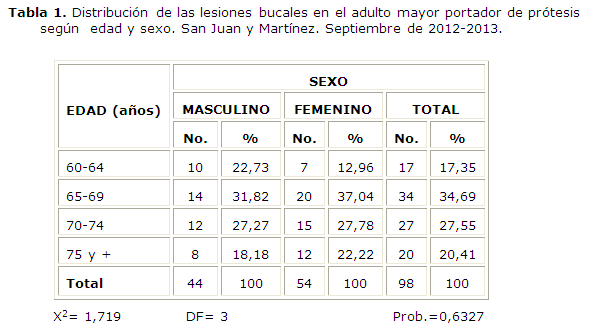Prosthetic rehabilitation in oral lesions of the aged adult
Keywords:
Dental prosthesis, Mouth mucosa/pathology.Abstract
Introduction: Lesions in the oral mucosa associated with the use of prosthesis constitute a considerable health problem, especially in geriatric patients.Objective: to characterize the oral lesions in geriatric patients prosthetically rehabilitated.
Material and methods: a descriptive, cross-sectional and prospective study was performed in the neighborhood medical offices # 9 and 47 belonging to Hermanos Saíz Dentistry Clinic of San Juan y Martinez Municipality (Pinar del Río), from September 2012 to September 2013. The target group comprised 165 patient prosthetically rehabilitated, out of which 98 made up the sample, for presenting oral lesions resulting from the use of prostheses. As summarizing measurements the absolute number and the percentage were used.
Results: the greatest numbers of patients were in the age group of 65-69 years. The most affected sex was the female, while lesions were found mainly to the maxillary bone and in patients who use complete acrylic dentures. The patients who presented bad dentures hygienic habits were more prone to present oral lesions. The greatest number of lesions was found in not-smoking patients.
Conclusions: the oral lesions were characterized in geriatric patients prosthetically rehabilitated, which makes possible to propose new research on factor associated with the origin and natural history of these lesions caused by the use of dentures, and thus to keep on communication with the involved people in providing care to the aged.
Downloads
References
1. Haw Kins RJ. Dental specification care. Oral health. Status and teeth treatment required for 85 year-old Canadian senior citizen. Spec Care Dent 1998; 18(4):164-9.
2. Díaz Martell Y, Martell Forte IC, Zamora Díaz JD. Afecciones de la mucosa oral encontradas en pacientes geriátricos portadoresde prótesis estomatológicas. Rev Cubana Estomatología[serie en internet]. 2007 [citado 7 Septiembre 2013]; 44(3): [aprox. 6 p.]. Disponible en: http://bvs.sld.cu/revistas/est/vol44_3_07/est02307.html
3. Lemus Cruz LM, TrianaK, Del Valle Selenenko O, Fuertes RufínL, Sáez Carriera R. Rehabilitaciones protésicas y su calidad como factor de riesgo en la aparición de lesiones en la mucosa bucal. Rev Cubana Estomatología[serie en internet]. 2009 ene-mar [citado 18 Junio 2012]; 46(1): [aprox. 7 p.]. Disponible en: http://scielo.sld.cu/scielo.php?pid=S0034-75072009000100003&script=sci_arttext
4. Rodríguez V, Arellano l, Zambrano R, Roldáni MT. Lesiones de los tejidos blandos de soporte en pacientes portadores de dentaduras totales. Los Nevados, estado Mérida. Rev Odontológica de los Andes [serie en internet]. 2007 ene-jun [citado 4 Junio 2012]; 2(1): [aprox. 8 p.]. Disponible en:http://www.imbiomed.com.mx/1/1/articulos.php?method=showDetail&id_articulo=47169&id_seccion=2994&id_ejemplar=4780&id_revista=177
5. Expósito Sánchez JE, González Olazábal M, Ruiz Calabuch H. Factores de riesgos de la estomatitis sub-prótesis en los pacientes del municipio de Taguasco. 2008-2009. Rev Gaceta Médica Espirituana[serie en internet]. 2010[citado 17 Mayo 2012]; 12(2): [aprox. 6 p.]. Disponible en: http://bvs.sld.cu/revistas/gme/pub/vol.12.%282%29_03/p3.html
6. Ettingeer RL, Jacobson JR. Tratamiento con prótesis total para el paciente geriátrico. Rev Clínicas Odontológicas de Norteamérica. 1996; 1: 247-61.
7. Piloto MM. Estadística Piloto: paquete estadístico digital educacional para las investigaciones epidemiológicas. Rev Ciencias Médicas[serie en internet]. 2010 oct[citado 17 mayo 2012]; 14(4): [aprox. 8 p.]. Disponible en: http://scielo.sld.cu/scielo.php?script=sci_arttext&pid=S1561-31942010000400004
8. Gonzáles RM, Herrera IB, Osorio M, Madrazo D. Principales lesiones bucales y factores de riesgo presentes en población mayor de 60 años. Rev Cubana Estomatología[serie en internet]. 2010 ene-mar[citado 7 septiembre 2013]; 47(1): [aprox. 15 p.]. Disponible en: http://scielo.sld.cu/scielo.php?script=sci_arttext&pid=S0034-75072010000100009&lng=es&nrm=iso
9. García Alpizar B, Benet Rodríguez M, Castillo Betancourt EE. Prótesis dentales y lesiones mucosas en el adulto mayor. Rev Medisur[serie en internet]. 2010[citado 17 Mayo 2012]; 8(1): [aprox. 7 p.]. Disponible en: http://scielo.sld.cu/scielo.php?pid=S1727-897X2010000100008&script=sci_arttext
10. Montero JM, Torres M, Fundora M. Lesiones bucales en el paciente geriátrico portador de prótesis total. Rev Mediciego[serie en internet]. 2010 [citado 19 septiembre 2013]; 10(S1): [aprox. 3p.]. Disponible en: http://www.bvs.sld.cu/revistas/mciego/vol10_sulp1_04/articulos/a13_v10_supl104.htm
11. Reyes FM, Espeso N, Hernández A. Promoción de salud bucal en la Tercera edad en un Centro Comunitario de Salud Mental. Rev Archivo Médico Camaguey[serie en internet]. 2009 may-jun[citado 7 septiembre 2013]; 13(3): [aprox. 9 p.]. Disponible en: http://scielo.sld.cu/scielo.php?pid=S1025-02552009000300002&script=sci_arttext

Published
How to Cite
Issue
Section
License
Authors who have publications with this journal agree to the following terms: Authors will retain their copyrights and grant the journal the right of first publication of their work, which will be publication of their work, which will be simultaneously subject to the Creative Commons Attribution License (CC-BY-NC 4.0) that allows third parties to share the work as long as its author and first publication in this journal are indicated.
Authors may adopt other non-exclusive license agreements for distribution of the published version of the work (e.g.: deposit it in an institutional telematic archive or publish it in a volume). Likewise, and according to the recommendations of the Medical Sciences Editorial (ECIMED), authors must declare in each article their contribution according to the CRediT taxonomy (contributor roles). This taxonomy includes 14 roles, which can be used to represent the tasks typically performed by contributors in scientific academic production. It should be consulted in monograph) whenever initial publication in this journal is indicated. Authors are allowed and encouraged to disseminate their work through the Internet (e.g., in institutional telematic archives or on their web page) before and during the submission process, which may produce interesting exchanges and increase citations of the published work. (See The effect of open access). https://casrai.org/credit/


